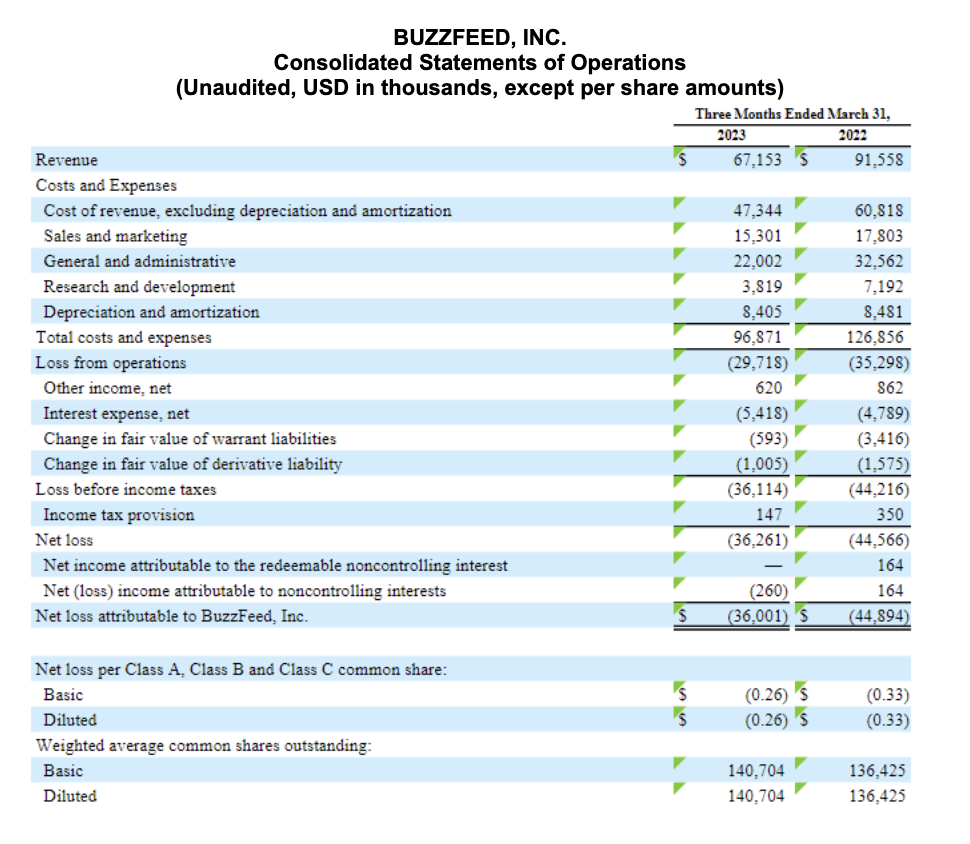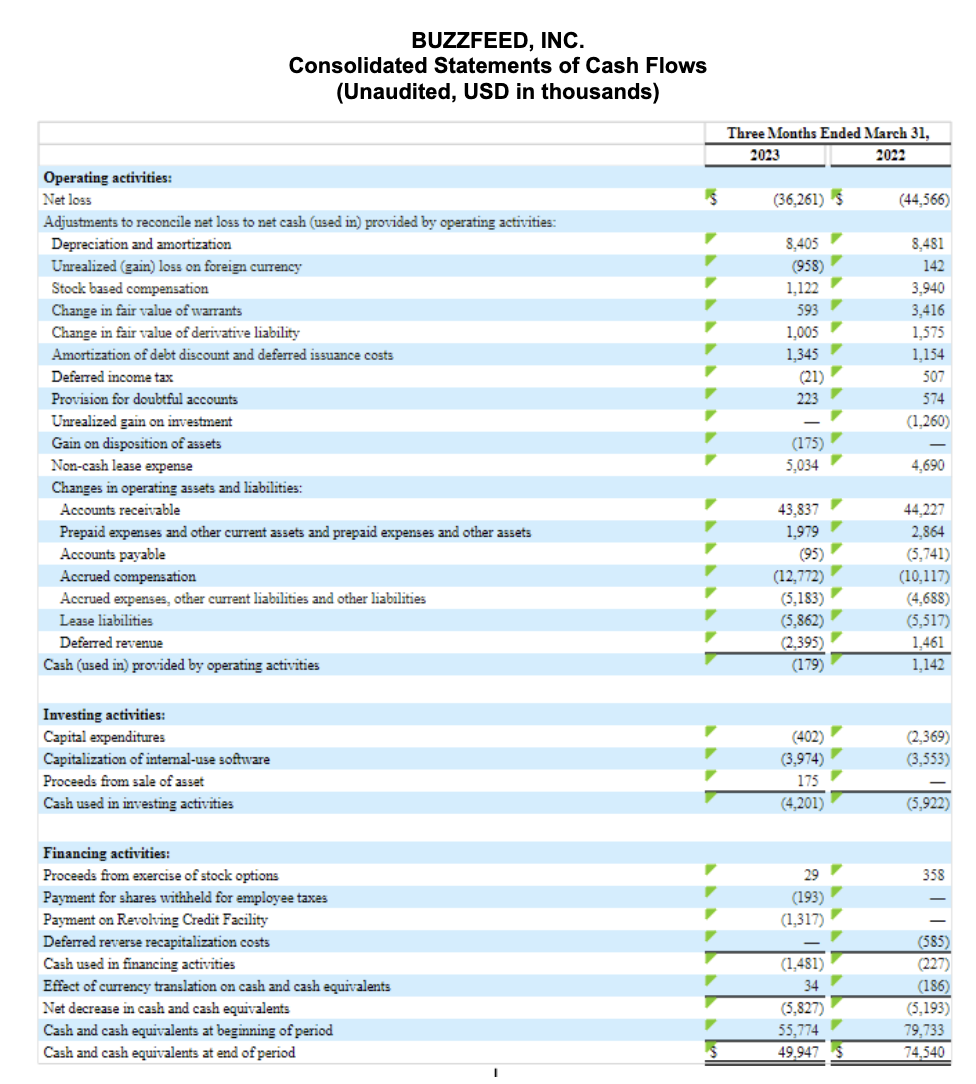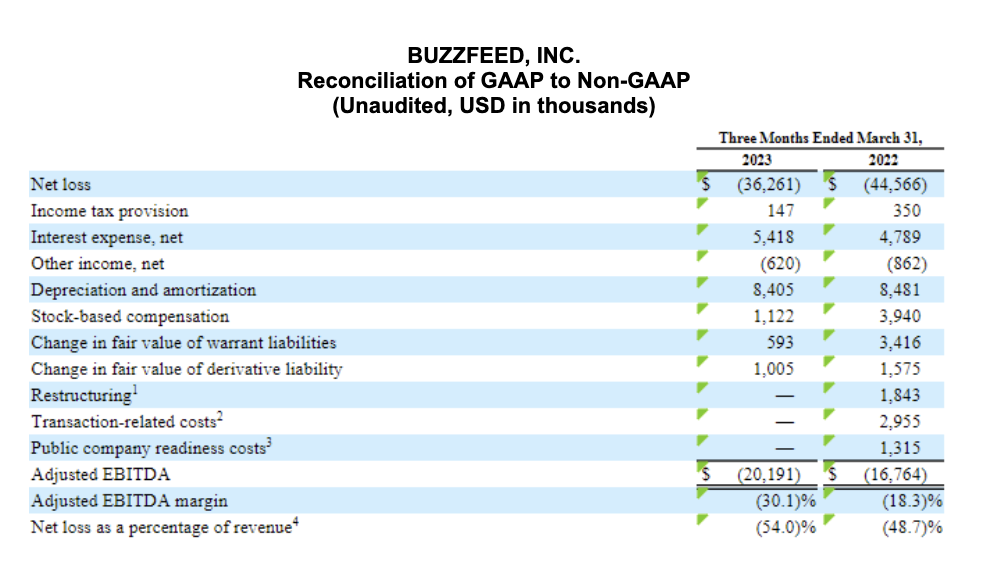NEW YORK – (May 9, 2023) – BuzzFeed, Inc. (“BuzzFeed” or the “Company”) (Nasdaq: BZFD), a premier digital media company for the most diverse, most online, and most socially engaged generations the world has ever seen, today announced financial results for the first quarter ended March 31, 2023.
“We have reached an inflection point in digital media. Over the last few months, we have made significant strategic and organizational changes to position the business for long-term growth. Adaptation is in our DNA. By leaning into Creators and AI, I believe we can unlock new opportunities across our portfolio of trusted brands — including Tasty, First we Feast, Complex, HuffPost, and BuzzFeed” said Jonah Peretti, BuzzFeed Founder & CEO.
First Quarter 2023 Financial and Operational Highlights
- BuzzFeed delivered Q1 revenues of $67.2 million, declining 27% compared to the first quarter of 2022
- Advertising revenue declined 30% year-over-year to $34.2 million
- Content revenue declined 33% year-over-year to $21.6 million
- Commerce and other revenues grew 6% year-over-year to $11.3 million
- Net loss was $36.3 million, compared to a net loss of $44.6 million in the first quarter of 2022
- Adjusted EBITDA loss was $20.2 million, compared to Adjusted EBITDA loss of $16.8 million in the first quarter of 2022
- Time Spent remained relatively consistent year-over-year, with a 3% decrease in overall Time Spent to 109 million hours
- BuzzFeed ended the period with cash and cash equivalents of approximately $50 million
Second Quarter 2023 Financial Outlook
For the second quarter of 2023:
- We expect overall revenues in the range of $76 to $81 million
- We expect Adjusted EBITDA in the range of $0 to $4 million
These statements are forward-looking and actual results may differ materially as a result of many factors. Refer to “Forward-Looking Statements” below for information on factors that could cause our actual results to differ materially from these forward-looking statements.
1 Adjusted EBITDA is a non-GAAP financial measure. Please refer to “Non-GAAP Financial Measures” below for a description of how it is calculated and the tables at the back of this earnings release for a reconciliation of our GAAP and non-GAAP results.
2 Excludes Facebook; see below.
Please see “Non-GAAP Financial Measures” below for a description of how Adjusted EBITDA is calculated. While Adjusted EBITDA is a non-GAAP financial measure, we have not provided guidance for the most directly comparable GAAP financial measure — net loss — due to the inherent difficulty in forecasting and quantifying certain amounts that are necessary to forecast such measure. Accordingly, a reconciliation of non-GAAP guidance for Adjusted EBITDA to the corresponding GAAP measure is not available.
Quarterly Conference Call
BuzzFeed’s management team will hold a conference call to discuss our first quarter 2023 results today, May 9, at 5PM ET. The call will be available via webcast at investors.buzzfeed.com under the heading News & Events. To participate via telephone, please dial 833-634-1260 (toll-free) or 412-317-6021 (international) and ask to join the BuzzFeed, Inc. call. A replay of the call will be made available at the same URL.
Additionally, BuzzFeed, Inc. will be hosting a virtual Investor Day on Thursday, May 11, 2023 at 1:00pm ET. The event will be streamed via webcast and followed by a live Q&A session. Registration for the event is now open on our Investor Relations site at investors.buzzfeed.com and a replay of the event will be made available at the same URL.
We have used, and intend to continue to use, the Investor Relations section of our website at investors.buzzfeed.com as a means of disclosing material nonpublic information and for complying with our disclosure obligations under Regulation FD.
Definitions
BuzzFeed reports revenues across three primary business lines: Advertising, Content and Commerce and other. The definition of “Time Spent” is also set forth below.
- Advertising revenues are primarily generated from advertisers for ads distributed against our editorial and news content, including display, pre-roll and mid-roll video products sold directly to brands and also programmatically. We distribute these ad products across our owned and operated sites as well as third-party platforms, primarily YouTube and Apple News.
- Content revenues are primarily generated from clients for custom assets, including both long-form and short-form content, from branded quizzes to Instagram takeovers to sponsored content and content licensing. Revenues for film and TV projects produced by BuzzFeed Studios and Complex Networks are also included here.
- Commerce and other revenues consist primarily of affiliate commissions earned on transactions initiated from our editorial shopping content. Revenues from our product licensing businesses are also included here. Additionally, we generate other revenues from the production of live and virtual events such as ComplexCon and ComplexLand.
Time Spent captures the time audiences spend engaging with our content across our owned and operated sites, as well as YouTube and Apple News, as measured by Comscore. This metric excludes time spent with our content on platforms for which we have minimal advertising capabilities that contribute to our Advertising revenues, including TikTok, Facebook, Instagram, Snapchat and Twitter. There are inherent challenges in measuring the total actual number of hours spent with our content across all platforms; however, we consider the data reported by Comscore to represent industry-standard estimates of the time actually spent on our largest distribution platforms with our most significant monetization opportunities. Effective January 1, 2023, we exclude time spent on Facebook from our measure of Time Spent as our monetization strategy is increasingly focused on advertising on our owned and operated properties, and Facebook now contributes an immaterial amount of advertising revenue. Time Spent on Facebook, as reported by Facebook, was approximately 22 million hours and approximately 72 million hours for the three months ended March 31, 2023 and 2022, respectively, which is not included in Time Spent discussed above.
About BuzzFeed, Inc.
BuzzFeed, Inc. is home to the best of the Internet. Across pop culture, entertainment, shopping, food and news, our brands drive conversation and inspire what audiences watch, read, and buy now — and into the future. Born on the Internet in 2006, BuzzFeed is committed to making it better: providing trusted, quality, brand-safe news and entertainment to hundreds of millions of people; making content on the Internet more inclusive, empathetic, and creative; and inspiring our audience to live better lives.
Non-GAAP Financial Measures
Adjusted EBITDA and Adjusted EBITDA margin are non-GAAP financial measures and represent key metrics used by management and our board of directors to measure the operational strength and performance of our business, to establish budgets, and to develop operational goals for managing our business. We define Adjusted EBITDA as net loss, excluding the impact of net (loss) income attributable to noncontrolling interests, income tax provision, interest expense, net, other income, net, depreciation and amortization, stock-based compensation, change in fair value of warrant liabilities, change in fair value of derivative liability, restructuring costs, transaction-related costs, public company readiness costs, and other non-cash and non-recurring items that management believes are not indicative of ongoing operations. Adjusted EBITDA margin is calculated by dividing Adjusted EBITDA by revenue for the same period.
We believe Adjusted EBITDA and Adjusted EBITDA margin are relevant and useful information for investors because they allow investors to view performance in a manner similar to the method used by our management. There are limitations to the use of Adjusted EBITDA and Adjusted EBITDA margin and our Adjusted EBITDA and Adjusted EBITDA margin may not be comparable to similarly titled measures of other companies. Other companies, including companies in our industry, may calculate non-GAAP financial measures differently than we do, limiting the usefulness of those measures for comparative purposes.
Adjusted EBITDA and Adjusted EBITDA margin should not be considered a substitute for measures prepared in accordance with GAAP. Reconciliations of non-GAAP financial measures to the most directly comparable financial results as determined in accordance with GAAP are included at the end of this press release following the accompanying financial data.
Forward-Looking Statements
Certain statements in this press release may be considered forward-looking statements within the meaning of Section 27A of the Securities Act of 1933, as amended, and Section 21E of the Securities Exchange Act of 1934, as amended, which statements involve substantial risks and uncertainties. Our forward-looking statements include, but are not limited to, statements regarding our management team’s expectations, hopes, beliefs, intentions or strategies regarding the future. In addition, any statements that refer to projections, forecasts (including our outlook for Q2 and FY 2023) or other characterizations of future events or circumstances, including any underlying assumptions, are forward-looking statements. The words “affect,” “anticipate,” “believe,” “can,” “contemplate,” “continue,” “could,” “estimate,” “expect,” “forecast,” “intend,” “may,” “might,” “plan,” “possible,” “potential,” “predict,” “project,” “seek,” “should,” “target,” “will,” “would” and similar expressions may identify forward-looking statements, but the absence of these words does not mean that a statement is not forward-looking. Forward-looking statements may include, for example, statements about: (1) anticipated trends, growth rates, and challenges in our business and in the markets in which we operate; (2) demand for products and services and changes in traffic; (3) changes in the business and competitive environment in which we operate; (4) developments and projections relating to our competitors and the digital media industry; (5) the impact of national and local economic and other conditions and developments in technology, each of which could influence the levels (rate and volume) of our advertising, the growth of our business and the implementation of our strategic initiatives; (6) poor quality broadband infrastructure in certain markets; (7) technological developments including artificial intelligence; (8) our success in retaining or recruiting, or changes required in, officers, key employees or directors; (9) our business, operations and financial performance, including expectations with respect to our financial and business performance and the benefits of our restructuring, including financial projections and business metrics and any underlying assumptions thereunder and future business plans and initiatives and growth opportunities; (10) our future capital requirements and sources and uses of cash, including, but not limited to, our ability to obtain additional capital in the future in a higher interest rate environment and any impacts of bank failures or any restrictions on our ability to access our cash and cash equivalents; (11) expectations regarding future acquisitions, partnerships or other relationships with third parties; (12) developments in the law and government regulation, including, but not limited to, revised foreign content and ownership regulations; (13) the anticipated impacts of current global supply chain disruptions, further escalation of tensions between Russia and Western countries and the related sanctions and geopolitical tensions, as well as further escalation of trade tensions between the United States and China; the inflationary environment; the tight labor market; the continued impact of the COVID-19 pandemic and evolving strains of COVID-19; and other macroeconomic factors on our business and the actions we may take in the future in response thereto; and (14) our ability to maintain the listing of our Class A common stock and warrants on the Nasdaq Stock Market LLC.
The forward-looking statements contained in this press release are based on current expectations and beliefs concerning future developments and their potential effects on us. There can be no assurance that future developments affecting us will be those that we have anticipated. These forward-looking statements involve a number of risks, uncertainties (some of which are beyond our control) or other assumptions that may cause actual results or performance to be materially different from those expressed or implied by these forward-looking statements. These risks and uncertainties include, but are not limited to, those factors described under the sections entitled “Risk Factors” in the Company’s annual and quarterly filings with the Securities and Exchange Commission. Should one or more of these risks or uncertainties materialize, or should any of our assumptions prove incorrect, actual results may vary in material respects from those projected in these forward-looking statements. There may be additional risks that we consider immaterial or which are unknown. It is not possible to predict or identify all such risks. We do not undertake any obligation to update or revise any forward-looking statements, whether as a result of new information, future events or otherwise, except as may be required under applicable securities laws.
###
Contacts
Media Contact
Carole Robinson, BuzzFeed: carole.robinson@buzzfeed.com
Investor Relations Contact
Amita Tomkoria, BuzzFeed: investors@buzzfeed.com





(1) For the three months ended March 31, 2022, reflects costs associated with the organizational changes to align sales and marketing and general and administrative functions as well as changes in content to better serve audience demands. We exclude restructuring expenses from our non-GAAP measures because we believe they do not reflect expected future operating expenses, they are not indicative of our core operating performance, and they are not meaningful in comparisons to our past operating performance.
(2) Reflects transaction-related costs and other items which are either not representative of our underlying operations or are incremental costs that result from an actual or contemplated transaction and include professional fees, integration expenses, and certain costs related to integrating and converging IT systems.
(3) Reflects one-time initial set-up costs associated with the establishment of our public company structure and processes.
(4) Net loss as a percentage of revenue is included as the most comparable GAAP measure to Adjusted EBITDA margin, which is a Non-GAAP measure.
